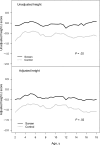Pubertal Height Growth and Adult Height in Cystic Fibrosis After Newborn Screening
- PMID: 27244789
- PMCID: PMC4845866
- DOI: 10.1542/peds.2015-2907
Pubertal Height Growth and Adult Height in Cystic Fibrosis After Newborn Screening
Abstract
Background: To examine long-term growth benefit of newborn screening (NBS), adolescent peak height velocity (PHV), and adult height were compared between the screened (diagnosed early via NBS) and the control (identified generally by symptoms) in the Wisconsin Randomized Clinical Trial.
Methods: Data from 107 children born in 1985-1994 and followed through 2012 were analyzed. PHV was estimated by a semiparametric growth curve model and compared with Tanner reference.
Results: Meconium ileus (MI; n = 25) was associated with the worst pubertal growth and adult height, including 1 child who did not experience apparent PHV; children with pancreatic sufficiency (n = 18) achieved the best growth (normal PHV and adult height). In children with pancreatic insufficiency without meconium ileus (n = 64), the subgroup most likely to benefit from NBS, screened children had similar PHV but better adult height compared with controls. Specifically, in boys, the screened group (n = 22) achieved normal PHV (9.5 cm at 13.5 years); the control group (n = 19) had similar onset age (13.6 years) but 0.6-cm lower magnitude (P = .08). In girls, the screened group (n = 10) had somewhat later (12.5 years vs 11.7 years, P = .12) and lower PHV (7.3 cm vs 7.9 cm, P = .33) than the controls (n = 13), coinciding with later menarche (13.6 years vs 12.2 years, P = .10). Adult height was taller in the screened than the control (50th vs 29th percentile, P = .02), even after adjusted for genetic potential (32nd vs15th percentile, P = .006). Differences in adult height were primarily attributable to NBS and better prepubertal growth.
Conclusions: Early linear growth benefits of NBS were sustained through puberty, leading to better adult height in cystic fibrosis.
Copyright © 2016 by the American Academy of Pediatrics.
Conflict of interest statement
Figures
References
-
- Sproul A, Huang N. Growth pattern in children with cystic fibrosis. J Pediatr. 1964;65:664–676 - PubMed
-
- Beker LT, Russek-Cohen E, Fink RJ. Stature as a prognostic factor in cystic fibrosis survival. J Am Diet Assoc. 2001;101(4):438–442 - PubMed
-
- Vieni G, Faraci S, Collura M, et al. . Stunting is an independent predictor of mortality in patients with cystic fibrosis. Clin Nutr. 2013;32(3):382–385 - PubMed
-
- Cystic Fibrosis Foundation National Cystic Fibrosis Patients Registry Annual Data Report, 2004. Bethesda, MD: Cystic Fibrosis Foundation; 2005
Publication types
MeSH terms
Grants and funding
LinkOut - more resources
Full Text Sources
Other Literature Sources
Medical
Research Materials
Miscellaneous


